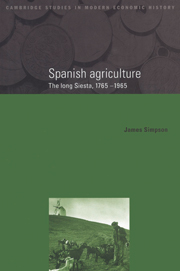Book contents
- Frontmatter
- Contents
- List of illustrations
- List of tables
- Acknowledgements
- Note on the regional division of Spain
- Abbreviations and conventions
- Introduction
- Part I The relative backwardness of Spanish agriculture
- Part II Traditional technologies and market opportunities, 1765–1880
- Part III The limits to technical change, 1880–1936
- 5 Soil fertility and the chemical revolution
- 6 Intensive cultivation and irrigation – a solution to low productivity?
- 7 The reluctance to mechanise
- Part IV Markets and institutions, 1880–1936
- Part V The State and the end of traditional agriculture
- Conclusion
- Appendix Estimates of agricultural output and consumption in nineteenth-century Spain
- Bibliography
- Index
7 - The reluctance to mechanise
Published online by Cambridge University Press: 04 December 2009
- Frontmatter
- Contents
- List of illustrations
- List of tables
- Acknowledgements
- Note on the regional division of Spain
- Abbreviations and conventions
- Introduction
- Part I The relative backwardness of Spanish agriculture
- Part II Traditional technologies and market opportunities, 1765–1880
- Part III The limits to technical change, 1880–1936
- 5 Soil fertility and the chemical revolution
- 6 Intensive cultivation and irrigation – a solution to low productivity?
- 7 The reluctance to mechanise
- Part IV Markets and institutions, 1880–1936
- Part V The State and the end of traditional agriculture
- Conclusion
- Appendix Estimates of agricultural output and consumption in nineteenth-century Spain
- Bibliography
- Index
Summary
In chapters 5 and 6 we saw the difficulties in improving crop yields through the use of chemical fertilisers and irrigation. With dry farming, small quantities of artificial fertilisers allowed an expansion of output through an extension of the area cultivated, but yields stagnated. By contrast, the lack of adequate water supplies, suitable crops and the inexperience of farmers, all contributed to limit the growth of irrigation to a relatively small area of Spain. As non-irrigated land accounted for 71 per cent of gross crop output in 1932, the best chance of increasing labour productivity, as in much of the United States, was through mechanisation.
In the first two sections of this chapter, I look at the cause of the delay in the use of reapers and threshers in the cereal harvest. I argue that even as late as the First World War, cheap labour and relatively expensive draught energy made mechanisation unprofitable in large areas of the country. In the final section the rapid modernisation of the country's olive oil presses from the early 1900s is linked to the international demand for better quality oils. The general conclusion is that farmers were ‘rational’ in their choice of techniques, adopting only those that promised to be profitable.
- Type
- Chapter
- Information
- Spanish AgricultureThe Long Siesta, 1765–1965, pp. 148 - 174Publisher: Cambridge University PressPrint publication year: 1996



